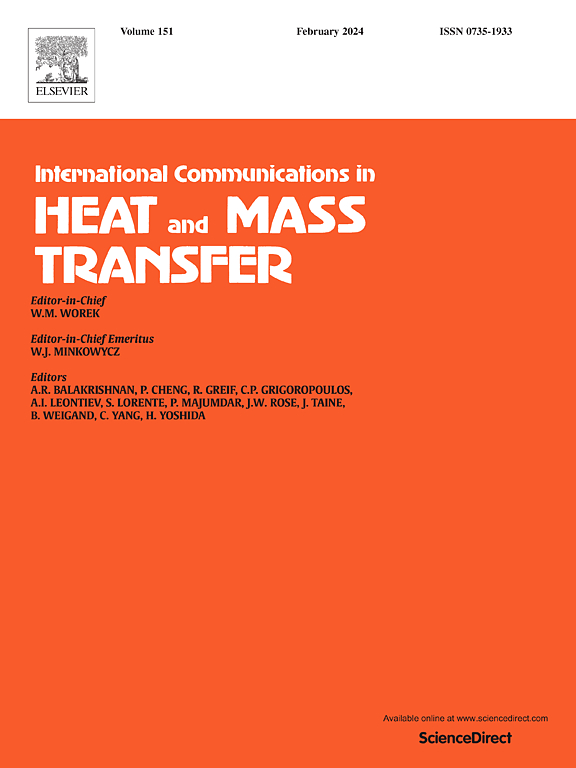Analysis and optimization of ground heat exchangers for heat transfer capacity under stratified soil conditions with heat-moisture and heat-seepage coupling
IF 6.4
2区 工程技术
Q1 MECHANICS
International Communications in Heat and Mass Transfer
Pub Date : 2025-05-08
DOI:10.1016/j.icheatmasstransfer.2025.109047
引用次数: 0
Abstract
In recent years, ground source heat pump (GSHP) systems have garnered widespread attention due to their high efficiency and environmental benefits. The heat transfer capacity of ground heat exchangers (GHEs) has emerged as a key research focus within GSHP technology. This paper employed a comprehensive approach, combining experimental verification, theoretical analysis, and numerical simulation, to optimize heat transfer capacity of GHEs under stratified soil conditions. Specifically, it examined effect of heat-moisture and heat-seepage coupling conditions. The study compared the heat transfer capacities of heat exchangers and a single heat exchanger under these conditions. The results indicated that, when considering heat-moisture and heat-seepage coupling, heat transfer capacity of GHEs could be enhanced by 22.93 % to 84.38 % under the most favorable working conditions, compared to the heat conduction condition alone. However, the average heat transfer capacity of heat exchangers was reduced by 4.49 % relative to a single heat exchanger when the coupling condition was taken into account. An innovative optimization method for the design parameters of GHEs has been proposed. The advancement provided a theoretical foundation for optimizing GHE designs in practical applications, effectively addressing soil thermal accumulation while enhancing heat transfer capacity, thereby improving the long-term operational stability of GSHP systems.
热湿热渗耦合分层土壤条件下地下换热器换热性能分析与优化
近年来,地源热泵系统以其高效、环保的优点得到了广泛的关注。地暖交换器的换热能力已成为地源热泵技术研究的热点。本文采用实验验证、理论分析和数值模拟相结合的综合方法,对分层土壤条件下温室气体的换热能力进行了优化。具体来说,考察了热湿和热渗耦合条件的影响。在这些条件下,研究比较了换热器和单个换热器的换热能力。结果表明:考虑热湿耦合和热渗耦合时,在最优工况下,温室气体的换热能力较单纯导热工况可提高22.93% ~ 84.38%;考虑耦合条件时,换热器的平均换热能力比单台换热器降低了4.49%。提出了一种创新的GHEs设计参数优化方法。这一进展为在实际应用中优化地源热泵设计提供了理论基础,有效解决土壤热积累问题,增强换热能力,从而提高地源热泵系统的长期运行稳定性。
本文章由计算机程序翻译,如有差异,请以英文原文为准。
求助全文
约1分钟内获得全文
求助全文
来源期刊
CiteScore
11.00
自引率
10.00%
发文量
648
审稿时长
32 days
期刊介绍:
International Communications in Heat and Mass Transfer serves as a world forum for the rapid dissemination of new ideas, new measurement techniques, preliminary findings of ongoing investigations, discussions, and criticisms in the field of heat and mass transfer. Two types of manuscript will be considered for publication: communications (short reports of new work or discussions of work which has already been published) and summaries (abstracts of reports, theses or manuscripts which are too long for publication in full). Together with its companion publication, International Journal of Heat and Mass Transfer, with which it shares the same Board of Editors, this journal is read by research workers and engineers throughout the world.

 求助内容:
求助内容: 应助结果提醒方式:
应助结果提醒方式:


